 |

|
|
|
| |
|
|
 San Diego Pond Service is North County's choice for experienced, dependable, friendly pond service and koi fish care! For clean, healthy, beautiful koi ponds, our pond maintenance is second to none! San Diego Pond Service maintains koi ponds and water gardens all over San Diego county. From Rancho Santa Fe ponds, to Carlsbad ponds, to La Jolla ponds, to Del Mar ponds, to Encinitas ponds, to Cardiff ponde, to Point Loma, to Old Town ponds, we are proud to serve the greater San Diego area! San Diego Pond Service is North County's pond owners "go to" pond cleaning and pond maintenance service company. We are pond service professionals and are passionate about clean, healthy koi fish ponds. Let San Diego Pond Service care for your koi pond, wwater garden, or fountain! Keep your pond beautiful! Dirty pond? San Diego Pond Service is the answer for clearer, cleaner pond water, pond muck removal, aquatic plant management, pond algae control, pond management, koi fish and underwater environment care, and pond filter system maintenance. Contact San DIego Pond Service today! Ranho Santa Fe ponds love San Diego Pond Service and Pond Maintenance! San Diego Pond Service is North County's choice for experienced, dependable, friendly pond service and koi fish care! For clean, healthy, beautiful koi ponds, our pond maintenance is second to none! San Diego Pond Service maintains koi ponds and water gardens all over San Diego county. From Rancho Santa Fe ponds, to Carlsbad ponds, to La Jolla ponds, to Del Mar ponds, to Encinitas ponds, to Cardiff ponde, to Point Loma, to Old Town ponds, we are proud to serve the greater San Diego area! San Diego Pond Service is North County's pond owners "go to" pond cleaning and pond maintenance service company. We are pond service professionals and are passionate about clean, healthy koi fish ponds. Let San Diego Pond Service care for your koi pond, wwater garden, or fountain! Keep your pond beautiful! Dirty pond? San Diego Pond Service is the answer for clearer, cleaner pond water, pond muck removal, aquatic plant management, pond algae control, pond management, koi fish and underwater environment care, and pond filter system maintenance. Contact San DIego Pond Service today! Ranho Santa Fe ponds love San Diego Pond Service and Pond Maintenance! |
 |
| KOI BREEDS: Koi fish, often referred to as Nishikigoi, are the product of hundreds of years of select breeding between common Asian and German carp. Different koi breeds can be found in a variety of colors ranging from pure white to yellow, orange, red, blue, black, even green! Their patterns and color combinations are unique to each individual koi fish. The most popular koi are typically a combination of red, black, and white. Some koi come with long fins (Butterfly Koi) or can be breed without scales (Doitsu Koi), giving them a sleek, streamline appearance. Koi ponds whose koi breeds are well represented and balanced in numbers really show well. Everyone has their own particular favorites, what's yours? At San Diego Pond Service, we enjoy observing and caring for all types of exotic, beautiful koi. |
 |
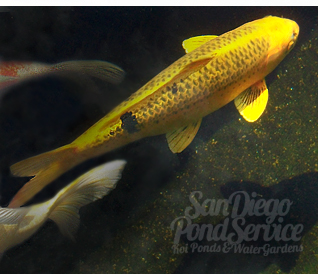 |
|
 |
|
 |
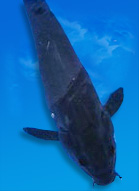 |
 |
MAGOI (Mah-Go-Ee) |
| In Magoi, the scales are actually deep bronze, but the fish appear black when viewed from above. Magoi are not recognized as true koi by some show organizers, but that does not stop them from being kept. Free of the stunting effects that can arise from selective breeding for color or pattern, these fish can become huge. For that reason, Magoi blood is being reintroduced into some Go Sanke bloodlines to speed and maximize growth. This breed often gets lost in the dark backgrounds of koi pond surfaces. |
 |
|
|
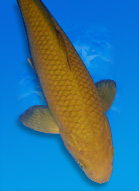 |
|
CHAGOI (Ch-Aw-Go-Ee) |
| Chagoi are uniform brown koi. The word "Cha", derived from the Chinese/Japanese word for tea, describes the color of this breed. They are noted for two distinct qualities: their capacity to grow very large and their extreme friendliness. Introducing a Chagoi to a pond full of nervous koi has a calming effect, speeding up the hand-feeding training process. The color of Chagoi can vary from saffron through reddish brown to almost black, yet the paler the koi the more highly it's valued. High quality, blemish-free scale reticulation is a requirement. Metallic Gin-Rin Chagoi are also finding favor. |
 |
|
|
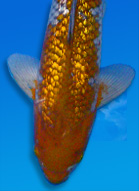 |
|
OCHIBA SHIGURE (Oh-Chee-Bah-She-Ger-Ee) |
| Soragoi are plain blue-gray koi. They are not a popular variety in their own right, but crossed with Chagoi they become Ochiba Shigure. Here, the gray base color of the Soragoi is patterned with the brown of the Chagoi. An Ochiba breed is a solid bronze scaled koi. The Ochiba Shigure has Kohaku-like markings, but more often the brown is confined to the head or to small patches on the body. Doitsu(scaleless) and Gin-Rin(metallic) styled Ochiba can also be found. |
 |
|
|
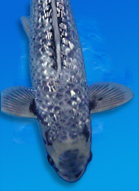 |
|
MATSUKAWABAKE (Maht-Soo-Kah-Wah-Bah-Key) |
| The Matsukawabake is an oddity, in that the distribution of black and white areas changes according to the seasons and the temperature of the water in which it is kept. However, this does not amount to a complete reversal of pattern. The koi can turn completely black or completely white under some circumstances, but can display interesting shadowy black sumi in the transition periods. Gin-Rin Goshiki and Doitsu Goshiki add even more complexity to an already fathomless variety. Interesting fish, nice addition to the koi collection. |
 |
|
|
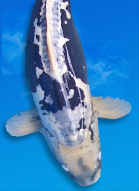 |
|
KUMONRYU (Koo-Mon-Roo) |
| Kumonryu, fist appeared in the 1980s, is the most popular of all black koi derivatives in Kawarimono. The name means "dragon fish" and is applied to these koi because their markings are reminiscent of the coiled dragon bodies depicted in Oriental paintings. Kumonryu are always Doitsu, sharpening the contrast between the white and black on the body. Beny Kumonryu exhibit blotches of solid red and are very impressive. Patterning can be highly variable; the best examples show large, wavy-edged blocks of white along the flanks and the top of the body. However, these fish can change colors pending season or water tempe/quality. |
 |
|
|
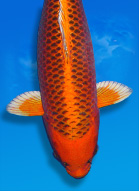 |
|
MATSUBA OGON (Maht-Soo-Bah-O-Gan) |
| Matt-scaled Matsuba are grouped in Kawarimono, but their metallic equivalents are benched Hikarimono. The most commonly available are Kin Matsuba (metallic gold/yellow, first produced in 1960) and the Gin Matsuba, its silver equivalent. Platinum (white) Matsuba and Aka Matsuba Ogon are not often seen. The pinecone scalation must be pronounced; if the black is more of a gray, these koi look washed out. Beginners are often confused by the Doitsu Matsuba Ogon, as the scale reticulation is not present. Instead, the black, German scales are aligned in the usual position, where they contrast sharply with the metallic body. Orange Doitsu Ogonare very rare. |
 |
|
|
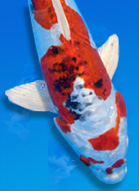 |
|
YAMATONISHIKI (Yah-Ma-Toe-Ni-She-Key) |
| The aristocrat of Hikarimoyo is the metallic Sanke known as Yamatonishiki. This variety came on to the market in the 1960s from two distinct sources, the first breeder being Seikichi Hoshino, who took 15 years to develop it. The complex process involved an initial cross between an Asagi and a Kin Kabuto and subsequent introductions of Sakura Ogon blood. A similar fish - Koshi-nishiki - was bred in Yamakoshi by crossing a Yamabuki Doitsu with a Gin Showa. Both are now grouped together as Yamatonishiki. |
 |
|
|
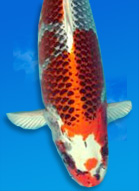 |
|
KUJAKU (Koo-Jack-Oo) |
| About 30 years ago, when koi keeping began to take off outside of Japan, the Bekko variety was quite fashionable, but like most fads, the popularity of this koi diminished over time. Though they may be hard to find, good specimens are truly stunning in their simplicity. Out of the three types of koi that are recognized as Bekko, only one - the Shiro Bekko - is widely known. Shiro Bekko is a Sanke derivative. Although they are still produced from parent fish of this variety, they are just as likely to be seen from spawnings of Sanke, especially Tancho Sanke. Bear in mind that any hi at all on a Shiro Bekko, even on the lips, technically makes it a Sanke. |
 |
|
|
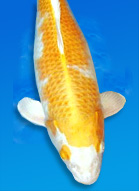 |
|
HARIWAKE (Har-Ee-Wah-Key) |
| |
Hariwake are derived from Ogon or Ogon Matsuba lineage and display two metallic colors - a platinum base overlaid with either yellow-gold (Yamabuki) or orange (Orenji) markings. These immensely bright and showy koi, much loved be beginners, are relatively easy to produce. The Doitsu versions are particularly popular. Ideally Hariwake should have clear platinum heads, although if the second color intrudes it is not a disaster. The nicest examples show a lot of metallic white on the body, but others have only small areas of this platinum skin. As in Hikarimono, the scales should convey a three-dimentional impression. |
 |
|
|
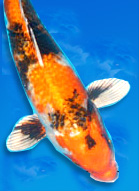 |
|
KIN SHOWA (Kin-Sho-Wah) |
| Metallic Showa are the result of crossing Showa and Utsurimono with Ogon. These koi breeds have become rare since they were first introduced and now are often underrepresented at shows for a few reasons. First, subtle appreciation of the finer points of koi is spreading from Japan to other parts of the world, and serious hobbyists are moving away from the flashier varieties to the more original, classic style koi. Second, while the metallic luster of Hikariutsuri is a plus, it has a tendency to tone down hi and sumi, so although these koi sparkle in the pond, their patterning is not always clear-cut or deep in color. This makes koi that overcome this potential drawback very valuable! |
 |
|
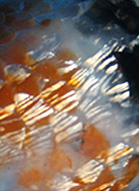 |
GIN RIN (GIN-RIN) |
| Ginrin scales are quite different from those on metallic koi. Instead of an overall gleam caused by the reflective pigment guanine, Ginrin scales have a reflective sheen over all or part of their surface creating a glimmering effect. The color they appear is determined by the pigment they overlay - silver (Gin) in the case of sumi or white, and golden (Kin) over hi. More than one type of Ginrin scale can appear on the same fish. Beta-Gin is usually found on the abdomen, along the lateral line or in individual rows toward the dorsal surface. Diamond and Kado-Gin tend to cover the back of the koi. Most hobbyists today do not differentiate between the types of Ginrin, but accept them as already beautiful koi. |
 |
|
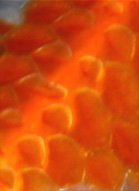 |
METALLIC |
| Metallic scales’ lustre is created through an abundance of colour cells that are excellent reflectors of light. Metallic koi pack in these reflective iridocytes into their skin, at the expense of losing the more intensely coloured chromatophores (or colour cells). Hence, these koi will rarely exhibit the same deep, solid, consistent reds and blacks equivalent non-metallic koi. Typically, judges form their opinions based on the shape and proportion of their body, the depth of the metallic sheen (referred to as lustre) and the clarity of the head will all count towards the quality of a metallic koi. |
 |
|
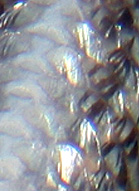 |
|
METALLIC GIN RIN |
| |
Even metallic fish are now being bred with this scalation and a good Ginrin Ogon is an unforgettable sight. To qualify as Ginrin, a koi should have more of these scales than it is possible to count as it swims past the observer - about 20 is the accepted minimum. Individual Ginrin scales on otherwise matt-scaled koi can look very attractive and do not detract from their value. A shimmering coat of reflective scales can lead the novice to fall for koi of otherwise limited attributes. Show judges in the Kin-Gin-Rin class, looking at a Ginrin Kohaku, will first ask themselves "Is this a good Kohaku in its own right?" Only if they are satisfied that it is will they mark it highly. |
 |
|
|
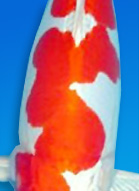 |
|
DOITSU (Doh-Eet-Sue) |
| |
Doitsu (German-scaled fish) typically describes koi with "no scales," other than enlarged scales along the lateral line and two lines running on either side of the dorsal fin. In Japan, the Doitsu classification applies only to Go Sanke, while in Western shows there is no separate category for any German-scaled fish, with the exception of Shusui. However, the growing popularity of these virtually naked-skinned koi suggests that Doitsu are highly desirable. There are a few Doitsu koi with their own names, such as Shusui and Kumonryu. |
 |
|
| Koi indentification information is courtesy of Blackwater Creek Koi Farms Inc. |
 |
 Koi Pg 1 | Koi Pg 2 Koi Pg 1 | Koi Pg 2 |
|
 |
 |
 |
KOI COLOR: Koi colors change throughout their road to maturity. All koi color comes from three types of pigment color mix: black, red, or yellow. It is advised to feed your koi color enhancing food to bring out these three natural pigments, especially during summer, when koi have heartier appetites. To protect their color, it is important to provide the most optimum underwater environment for your koi. If there is an abundance of pollutants (ammonia, nitrites, nitrates), your koi's color and vibrancy will fade. pH levels also have an effect on koi color. High pH levels of 8.0+ will cause your koi's black pigment to appear softer, while a more acidic pond water, around 6.0-7.0pH, will cause your koi's red pigment to fade. Hardness of the water plays a role as well. Soft water affects red pigment, while harder water fades out black pigment. Koi color is richer in spring and fall months, when water temps are slightly cooler.  |
 |
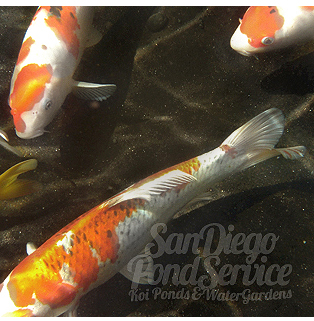 |
|
 |
 |
|
 |
 |
|
|
 |

 |
|
|
|
|
 |
 |
| ©2012 San Diego Pond Service | Property Of San Diego Pond Service |
| San Diego Pond Service is North County's choice for experienced, dependable, friendly pond service and koi fish care! For clean, healthy, beautiful koi ponds, our pond maintenance is second to none! San Diego Pond Service maintains koi ponds and water gardens all over San Diego county. From Rancho Santa Fe ponds, to Carlsbad ponds, to La Jolla ponds, to Del Mar ponds, to Encinitas ponds, to Cardiff ponde, to Point Loma, to Old Town ponds, we are proud to serve the greater San Diego area! San Diego Pond Service is North County's pond owners "go to" pond cleaning and pond maintenance service company. We are pond service professionals and are passionate about clean, healthy koi fish ponds. Let San Diego Pond Service care for your koi pond, wwater garden, or fountain! Keep your pond beautiful! Dirty pond? San Diego Pond Service is the answer for clearer, cleaner pond water, pond muck removal, aquatic plant management, pond algae control, pond management, koi fish and underwater environment care, and pond filter system maintenance. Contact San DIego Pond Service today! Ranho Santa Fe ponds love San Diego Pond Service and Pond Maintenance! |
| San Diego Pond Service is North County's choice for experienced, dependable, friendly pond service and koi fish care! For clean, healthy, beautiful koi ponds, our pond maintenance is second to none! San Diego Pond Service maintains koi ponds and water gardens all over San Diego county. From Rancho Santa Fe ponds, to Carlsbad ponds, to La Jolla ponds, to Del Mar ponds, to Encinitas ponds, to Cardiff ponde, to Point Loma, to Old Town ponds, we are proud to serve the greater San Diego area! San Diego Pond Service is North County's pond owners "go to" pond cleaning and pond maintenance service company. We are pond service professionals and are passionate about clean, healthy koi fish ponds. Let San Diego Pond Service care for your koi pond, wwater garden, or fountain! Keep your pond beautiful! Dirty pond? San Diego Pond Service is the answer for clearer, cleaner pond water, pond muck removal, aquatic plant management, pond algae control, pond management, koi fish and underwater environment care, and pond filter system maintenance. Contact San DIego Pond Service today! Ranho Santa Fe ponds love San Diego Pond Service and Pond Maintenance! |
|
 |
